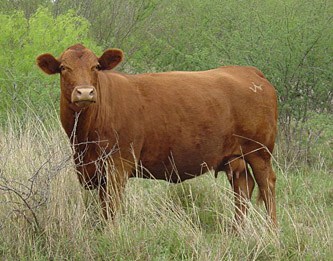Type the name of the breed you're looking for below
[wpdreams_ajaxsearchlite] Don't see the breed your're looking for? Click here and let us know!
Santa Cruz cattle
| Place of Origin | United States |
| Origin | King Ranch Santa Cruz cattle represent more than seven years of intense research and development aimed at creating a more market acceptable beef animal that produced superior results as both a feeder and seedstock animal. The new cattle are a composite breed, produced by first crossing Santa Gertrudis cows with Red Angus and Gelbvieh bulls. This initial union produces 1/2 Santa Gertrudis and 1/2 Red Angus males and females; as well as 1/2 Santa Gertrudis and 1/2 Gelbvieh males and females. These half bloods are then crossed back on each other to produce a 1/2 Santa Gertrudis, 1/4 Red Angus and 1/4 Gelbvieh composite animal, the finished product. This is King Ranch Santa Cruz, as composites are then bred to composites, fixing the characteristics desired in the cattle and demanded by today's beef market. Stephen J. Kleberg, Vice President of King Ranch, Inc. said that King Ranch Santa Cruz cattle have “excellent conformation, perform extremely well in the feedyard, and obtain maximum results at the packing plant.” Hal Hawkins, King Ranch animal physiologist, described the cattle as "very fertile, both male and female, reaching an early sexual maturity at 12 - 14 months of age. Weaning and yearling weights are excellent, and they are very gentle cattle that demonstrate good mothering instincts." |
| Appearance | In colour, they range from a light red or honey to a Santa Gertrudis cherry red. The cattle have proven very heat resistant and adapt extremely well to South Texas' harsh climate and environments. They range far and wide and work the large pastures of King Ranch very well. |
| Horns | The breed produces both polled (hornless) and horned individuals. |
| Cows Average Weight | 500 - 550 kg (1,102 - 1,213 lbs) |
| Bulls Average Weight | 800 - 900 kg (1,764 - 1,984 lbs) |
| Other Considerations | Early in 1987, the need for a more market acceptable beef animal at King Ranch was the topic of conversation from the working pens to the board room. Top producers in the beef and livestock industry were brought in to aid in the project. Educators from the major agricultural universities across the United States were invited to share their knowledge with King Ranch. Twenty-six professors from fourteen universities participated in the formulation of a master breeding plan. These specialists in the various research fields which undergird progressive livestock operations, like King Ranch, included carcass and meat experts, reproduction and physiology scientists, breeds and breeding selection specialists, geneticists, nutritionists, botanists, veterinary scientists, and climatologists. As a result of these meetings, King Ranch set some short and long term objectives in its breeding plan. Short term objectives included improved production (reproduction and fertility); improved market acceptability (carcass quality - grade and tenderness); and, cull cattle on strict economic considerations. Long term objectives included single breed type mating system using a composite breed; genetic policy that would produce a phenotypic look-alike; and, early sexual maturity with superior carcass quality and grade. The Santa Gertrudis breed was maintained, improved, and made more competitive. Two breeds were selected to add to the Santa Gertrudis to achieve these goals. Gelbvieh were chosen for their fertility, high growth, early maturity, shortened gestation length, and moderate milk production. Red Angus were selected to add early fertility, ease in calving, high carcass quality, efficiency, and polled characteristics. |



